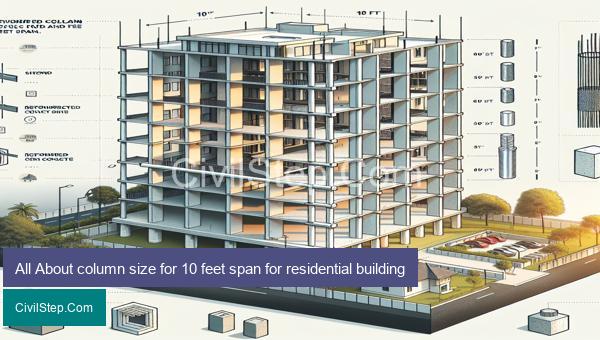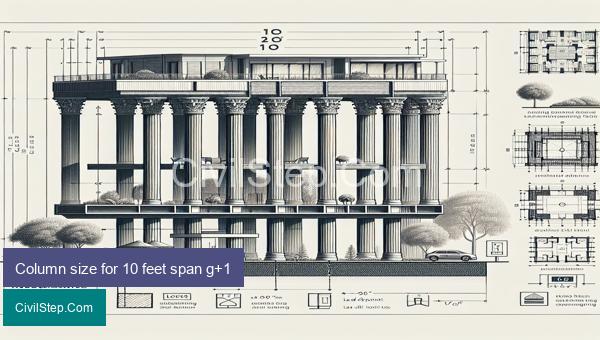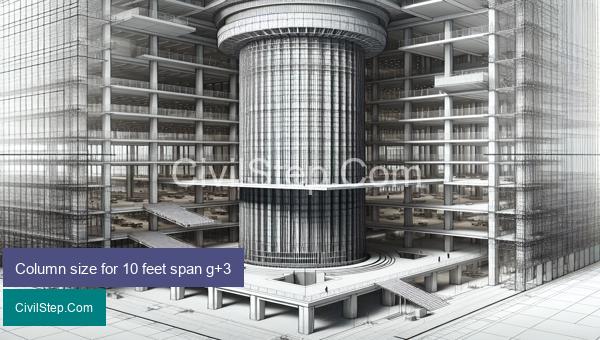
Choosing the right column size is crucial when constructing a residential building, as it plays a significant role in ensuring the structural stability and safety of the entire structure. Among the various factors that influence column size, the span or distance between columns is a critical consideration. In this article, we will delve into the importance of column size for a 10 feet span in residential building construction, discussing the different types of columns, their load-bearing capacities, and the overall impact of choosing the appropriate column size. Whether you are a homeowner or a builder, understanding the basics of column size for a 10 feet span can help you make informed decisions and avoid potential structural issues in the long run.
What is column size for 10 feet span for residential building

When designing a residential building, one important aspect to consider is the proper column size for the structure. The column size for a 10 feet span is a crucial factor that affects the stability and overall strength of the building.
The size of a column is determined by several factors, including the span of the building, type of load it is expected to bear, and the type of material being used for construction. For a 10 feet span in a residential building, the typical column size will be between 9 inches to 12 inches in width and depth.
In residential buildings, the primary purpose of a column is to support the weight of the structure above it. The load-bearing capacity of a column is dependent on its size and the material used. The larger the column size and the stronger the material, the more load it can carry. For a 10 feet span in a residential building, the weight of the building would be relatively light, so a smaller column size is typically sufficient.
Another aspect to consider when determining the column size for a 10 feet span is the type of material used. Commonly used materials for columns in residential buildings include concrete, steel, and wood. Each material has its own load-bearing capacity, and the appropriate column size will depend on the type of material used.
For example, a 9-inch x 9-inch column made of steel can support a larger load compared to a 9-inch x 9-inch column made of wood. It is important to consult with a structural engineer to determine the right column size based on the type of material used and the expected load the column will bear.
In addition to the structural aspect, the aesthetics of the building must also be considered when determining the column size. The size of the column should be in proportion to the overall size of the building. A column that is too thick or thin can affect the appearance of the building.
In conclusion, the column size for a 10 feet span in a residential building is typically between 9 inches to 12 inches, depending on the material used and the expected load. The size of the column should be carefully determined by a structural engineer to ensure the safety and stability of the building. Properly sized columns are necessary for a strong and durable residential building.
Column size for 10 feet span g+1

When designing a column for a 10 feet span for a G+1 (Ground plus one) structure, various factors need to be taken into consideration. The size and strength of the column play a significant role in providing adequate support and stability to the structure.
In general, the size of a column is determined by the load it needs to bear and the height it needs to support. In the case of a G+1 structure, the column will be subjected to the weight of the first and second floor, along with the roof and other live loads such as furniture and people. The soil conditions of the site also need to be considered, as a weaker soil would require a larger column size to provide sufficient structural support.
For a 10 feet span, the most commonly used column sizes are 9”x9” and 12”x9”. These sizes can support a maximum load of 40-50 tons. However, the final size of the column may vary depending on the building’s design, type of construction materials used, and the local building codes and regulations.
An important consideration when designing a column is its slenderness ratio. This is the ratio of the column’s length to its cross-sectional dimension. A lower slenderness ratio indicates a sturdier and stronger column. For a 10 feet span column, the ideal slenderness ratio should not exceed 12, meaning the column’s height should not exceed 12 times its width.
In addition to size and slenderness ratio, the column’s reinforcement must also be carefully calculated to provide adequate strength and prevent failure. The reinforcement consists of steel bars placed inside the column, which helps to counteract the tension forces that may occur in the column due to the loads it is subjected to. The exact quantity and size of reinforcement bars will depend on the structural design and the type of materials used.
In conclusion, the column size for a 10 feet span g+1 structure would typically be 9”x9” or 12”x9”, depending on various factors such as load, soil conditions, and the building’s design and construction materials. It is crucial to consult a structural engineer to determine the most appropriate column size for the specific structure to ensure safety and stability.
Column size for 10 feet span g+2

In civil engineering, column size is a crucial factor to consider when designing a building. It refers to the cross-sectional dimension of a column, which plays a significant role in supporting the load of a structure. In this article, I will discuss the column size required for a 10 feet span, ground plus two (g+2) building.
Firstly, let’s understand what a 10 feet span g+2 building means. A 10 feet span building is one where the distance between two columns is 10 feet. G+2 refers to a building that has a ground floor and two additional floors above it. This type of building is commonly found in residential, commercial, and industrial structures.
Now, when it comes to selecting the column size for a 10 feet span g+2 building, there are several factors that need to be considered. These include the type of material used, the load-bearing capacity, and the aesthetic requirements.
The most commonly used materials for columns in building construction are concrete, steel, and wood. Concrete columns are popular due to their high strength and durability. Steel columns are also widely used for their high load-bearing capacity and ease of construction. Wood columns are mostly suitable for low-rise buildings.
For a 10 feet span g+2 building, the recommended column size for a concrete column is 9″ x 9″ (225 mm x 225 mm) for the ground floor and 7″ x 7″ (175 mm x 175 mm) for the upper floors. This size is suitable for a low-rise building as it can efficiently support the load of the structure. However, the size may vary depending on the type of building and its location.
In the case of steel columns, the size will depend on the structural design and load requirements. Generally, for a 10 feet span g+2 building, the recommended size for steel columns is 127 x 76 x 13 kg/m UB (Universal Beam).
It is crucial to note that the column size also varies for different types of columns, namely rectangular, circular, and square. A square column is generally recommended for buildings with a square or rectangular footprint, while a circular column is suitable for buildings with curved walls or irregular shapes.
In addition to the structural requirements, the column size also depends on the aesthetic requirements of the building. Some buildings may require larger columns to create a sense of grandeur and give a visual appeal, while others may prefer slimmer columns for a modern and sleek look.
In conclusion, the column size for a 10 feet span g+2 building depends on various factors, including the material used, structural design, load-bearing capacity, and aesthetic preferences. It is crucial to have a well-designed and structurally sound column size to ensure the stability and strength of the building. Therefore, it is essential to consult a structural engineer to determine the most appropriate column size for a specific building project.
Column size for 10 feet span g+3

The column size for a 10 feet span in a G+3 building will depend on various factors such as the type of construction method, load-bearing capacity of the soil, type of materials used, and design calculations. However, as a civil engineer, I can provide some general guidelines that can help in determining the appropriate column size for a 10 feet span in a G+3 building.
1. Type of Construction Method: The type of construction method used for the building can significantly impact the column size required for a 10 feet span. In conventional construction, where columns are built using bricks or stones, the dimensions of the column will be larger compared to reinforced cement concrete (RCC) construction.
2. Load Bearing capacity of the soil: Before deciding on the column size for a 10 feet span, it is essential to determine the load-bearing capacity of the soil. This will help in understanding the maximum load the soil can bear, and accordingly, the column size can be calculated to adequately distribute the load.
3. Type of Materials Used: The type of materials used for the columns also affects their size. In RCC construction, columns are built using steel and concrete. The size of the steel reinforcement and the quality of the concrete used play a crucial role in determining the column size.
4. Design Calculations: Design calculations, based on the structural design of the building, will determine the appropriate size of the columns. The design calculations take into account the load-bearing capacity of the structure, seismic forces, and other factors to ensure the safety and stability of the building.
Based on the above factors, for a 10 feet span in a G+3 building, the recommended column size would be in the range of 9 inches x 9 inches to 12 inches x 12 inches. However, this can vary depending on the above factors. It is essential to consult a structural engineer for precise calculations and design to determine the most suitable column size for the building.
In conclusion, as a civil engineer, I would recommend considering all the above factors before finalizing the column size for a 10 feet span in a G+3 building. It is crucial to follow the necessary safety measures and design calculations to ensure the strength and stability of the structure.
Column size for 10 feet span g+4

In a g+4 building, the column size for a 10 feet span should be chosen carefully to ensure the structural integrity and safety of the building. The size of the column is determined by various factors such as the load on the column, type of material used, the height of the building, and the number of storeys.
In this scenario, the column size for a 10 feet span in a g+4 building can be determined by following the guidelines set by the Indian standard code of practice, IS 456:2000. According to this code, the minimum size of the column should not be less than 9”x9” or 230mmx230mm with a minimum of four bars of 12mm diameter for main reinforcement and two bars of 8mm diameter for distribution reinforcement.
The type of material used for the column also plays a crucial role in determining its size. In a g+4 building, reinforced cement concrete (RCC) is the most commonly used material for the columns. The strength of the concrete used should be at least M20 grade, with a minimum compressive strength of 20 N/mm2.
The height of the building is another factor that affects the column size for a 10 feet span. As the height increases, the load on the columns also increases, requiring thicker and stronger columns. In a g+4 building, the height is generally limited to 15-18 meters, making 9”x9” columns sufficient to support the load.
The number of storeys also influences the column size as it determines the total load on the column. In a g+4 building, the total load is comparatively low due to the limited number of storeys, and therefore, 9”x9” columns with adequate reinforcement are suitable.
Apart from these factors, the type of foundation used for the columns should also be considered while determining the column size. In a g+4 building, a shallow foundation is typically used, making the 9”x9” column size appropriate.
In conclusion, for a 10 feet span in a g+4 building, the minimum column size should be 9”x9” with four bars of 12mm diameter for main reinforcement and two bars of 8mm diameter for distribution reinforcement. However, the column size can also be increased depending on the design and load analysis by a structural engineer to ensure the safety and stability of the building.
Conclusion
In conclusion, when it comes to choosing the appropriate column size for a 10 feet span in a residential building, several factors must be taken into consideration. These include the type of construction, the load-bearing capacity, and the material used. It is important to consult with a structural engineer to ensure the safety and stability of the building. Additionally, regular maintenance and reinforcement of the columns should be carried out to ensure their longevity. By following these guidelines, you can ensure that your residential building is strong, stable, and able to withstand the given span. With proper column sizing, you can create a safe and sturdy structure that will last for years to come.
